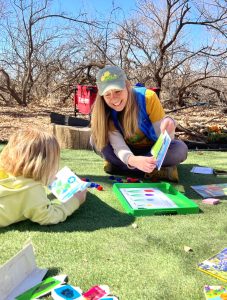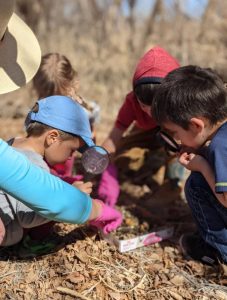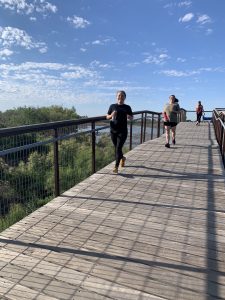
Teaching children and families about the wonders of nature in West Texas while preparing youngsters for kindergarten is one of the missions of I 20 Wildlife Preserve Education Coordinator Kari Warden.
She conducts the Wild at the Preserve Program designed for prekindergarten children. She has been working on it since she started about five and a half years ago.
“When I started it was a very small class, mostly of my friends as I practiced my way through it and developed the material. It has definitely evolved over the last five years,” Warden said.
It used to be just Warden sharing nature poems and walks. She discussed the philosophy of author Richard Louv who wrote “Last Child in the Woods: Saving Our Children from Nature Deficit Disorder.”
“That’s sort of his philosophy is this whole generation coming up is losing touch with the natural world and the healing benefits of it. The benefits are full body — from mind to wellness to even, in my case, kindergarten readiness,” Warden said.

“There’s much to be learned about patterns and cycles and just wildlife in general and being stewards in that role. That’s sort of the mission of the program is to just get families of young children comfortable with using their free time to be outdoors and … be aware of those benefits that are there and to not just think of it as an activity that they just squeezed in. To avoid that I’ve created … a six-week program similar to what they do at the Petroleum Museum with their STEM program. I have children who register for the class, sign up and pay. That way I can ensure that they attend the entire series of the program as opposed to drop-ins because I do really want it to be an experience. It’s meant to be for the parent and child to complete … it builds on each other. Each lesson is a piggy-back on the next,” she said.
Over the last couple of years, she’s split it into a hybrid program where it’s more like a storytime program.
“I call that Playtime at the Playa and it’s based off the exact same curriculum, the manipulatives and the stories that I recommend,” she said.
The poems and nature walk activities are there as well.
“It’s not given in a classroom-type setting. It’s more of a come-and-go. The parents are going to do most of the engaging with the children,” Warden said.
She added that she has materials there that she encourages families to use.
Warden also provides one-one-one activities as she becomes available.
She offers Playtime at the Playa twice a month.
“They’re what we call a hybrid of my curriculum. It’s a showcase. It’s an opportunity to meet and greet and see how we can better serve the community. Those are on our calendar under Playtime at the Playa. They happen one Friday of the month and one Tuesday of the month from 10 a.m. until 12 p.m. Those are open to anybody and really all ages. Typically because they are done during school hours it’s mostly either home school families or moms with preschoolers,” Warden said.

Her Wild in the Preserve class is heavy on kindergarten readiness.
“We do a lot of patterns and early emergent readers, (and) science readers with sight words. We practice shapes and all of that stuff using natural objects, obviously, so sorting things by color we find in nature; fine motor skills; gross motor skills; we have movement games” and other activities, she said.
She also has mimicry, like dramatic play like all the things you would find at a preschool but more condensed.
“I also created a handout for the parents to continue the learning at home with all kinds of extensions and activities, web articles and online stories that you can listen to that relate to the same topic. My idea is, if utilized properly, this curriculum could in my opinion suffice as a complete preschool curriculum,” Warden said.
“But I only meet with the families, like I said, one hour a week for six weeks,” she added.
But a lot of the families who are in her rostered class also attend the free classes.
“It is typically the same families who participate in these programs over and over again,” she said.
The biggest downfall currently is Warden’s availability to put on the programs. She is a homeschool mother of a fourth grader and a fifth grader and they are her biggest priority.
“I have created all of the materials in grab and go bags just like you might through the Texas Parks and Wildlife (Department),” Warden said.
She added that her children spend most of their time outdoors.
“With nature being as important as it is to me, it can be sort of a deficit around here where people don’t recognize it. They don’t appreciate it. They don’t know that it exists. I think that it’s important for these kids at a young age to realize the value of our Llano Estacado … and the wildlife that we do have. We need to protect it and we need to be concerned about it and we need it to know what it needs to stay healthy,” Warden said.



